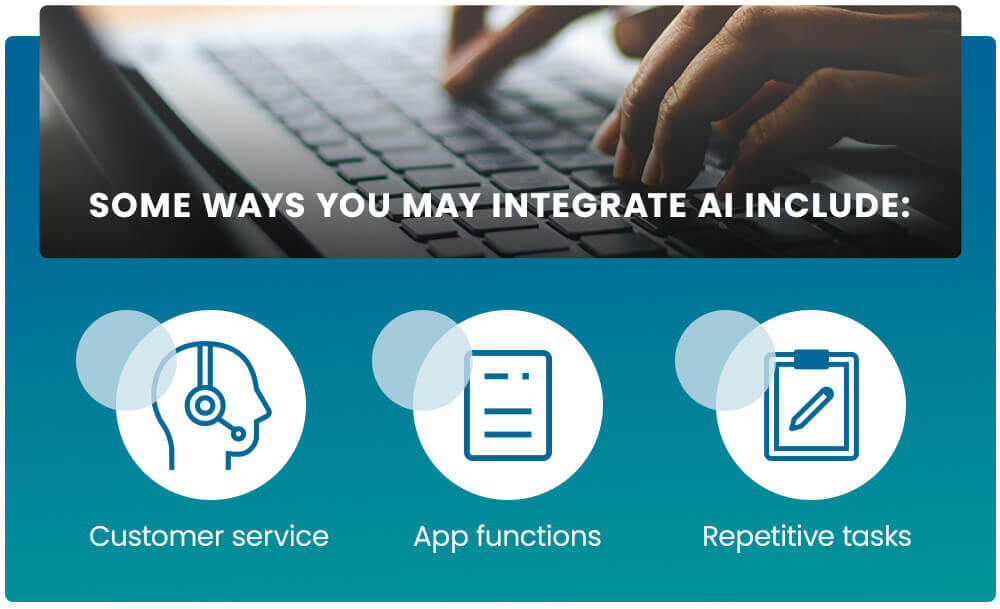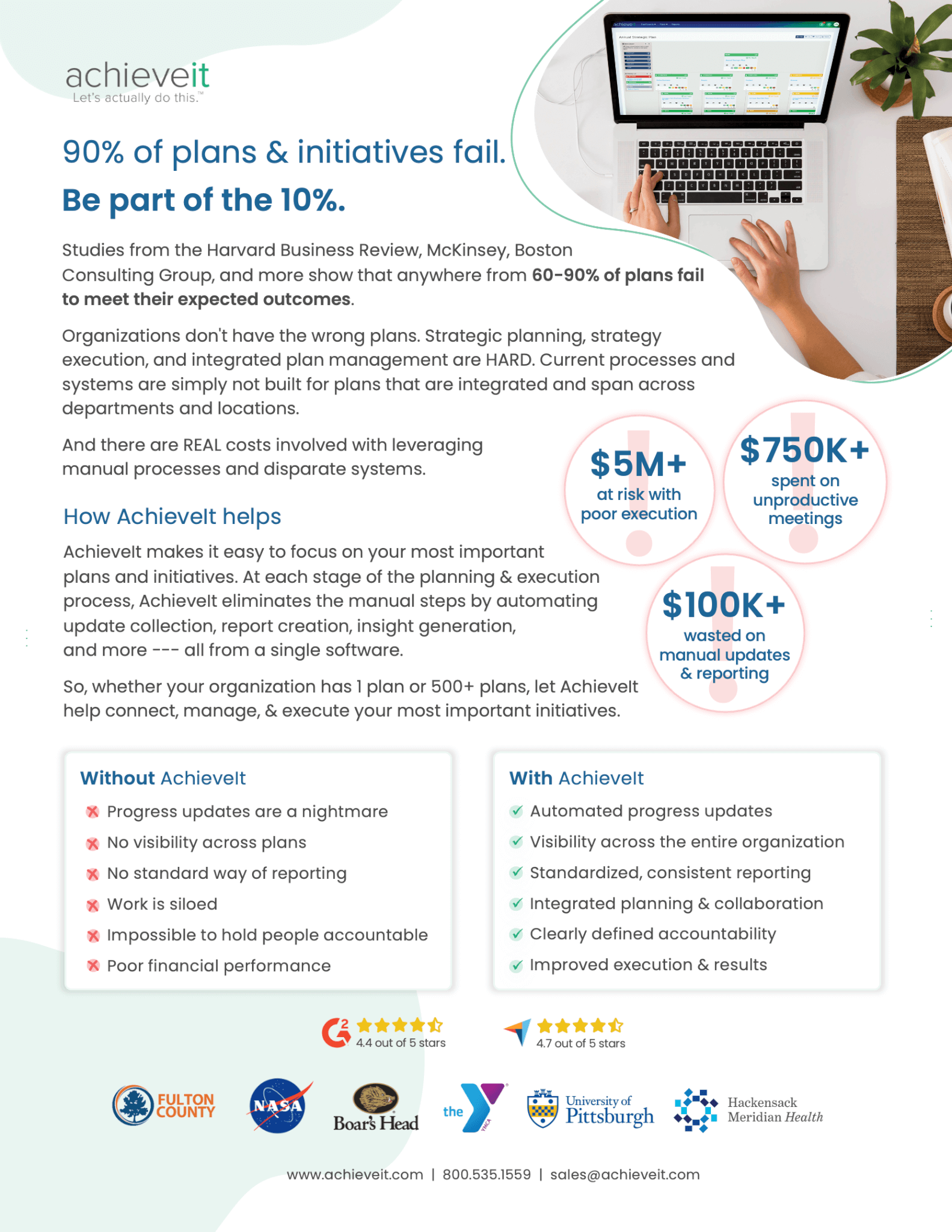Strategic planning trends constantly evolve as companies refine their strategies and consumers change their minds about what they want from brands. Strategic planning tools empower businesses to stay on top of these trends and make a lasting impact in their industries. Build your strategy for the future by evaluating these trends.

1. Resilience Planning
The last few years have come with extreme ups and downs. Economy shifts and market changes have significantly impacted new and established companies. Neglecting the importance of confronting unforeseen circumstances is one of the most common strategic planning failures. Businesses can gain confidence moving forward with resilience planning.
Resilience planning involves creating initiatives to expand business continuity during uncertain times. It comes with many advantages, such as fostering a more collaborative environment and enhancing visibility. The key to maintaining a resilient organization is developing unique approaches that enable flexibility and responsiveness. In any fast-changing environment, there’s always a need to consider “what if” scenarios. During unpredictable changes or volatile market fluctuations, your strategy and execution should be able to assess, adapt and realign your resources as needed.
Implementing new tools for strategic planning can enhance your approach’s overall effectiveness. Your future strategy should include tools to prevent or minimize the effects of cyberattacks, global pandemics, war, economic downturns, environmental events and the disruptions of a new competitor.

2. Collaboration
Strategic planning means little if your departments and teams operate separately. Cross-functional teams are essential for bringing your organization together and driving progress. Comprehensive strategy management tools can further help break down silos and improve accessibility to shared information.
Cross-functional collaboration enables leaders like you to leverage diverse perspectives, mitigate biases and challenge assumptions. Hearing from all levels of your organization during the brainstorming process ensures that team members who will be most affected by your future strategy will be heard. Additionally, approving a collaborative plan can set you up for a smoother journey. You’ll have increased confidence knowing that everyone accepts the planned actions and is ready to meet deadlines.

3. Speed
Many organizations operate in a fast-changing environment. However, outdated and manual strategy cycles can limit your organization’s potential. True innovation can help your teams thrive in fast-paced, ever-changing situations and maintain resilience.
Speed is often a strategy on its own, helping your business move in the right direction. As a strategic planning trend in 2024, improved speed can enable faster responses to disruption. The ability to adapt and maintain the flexibility to shift your strategy can help ensure successful strategy implementation.
4. Transparency
Just as with communication, transparency is vital in strategy planning and execution. Transparency helps your teams adapt and avoid confusion about your organization’s direction and focus. In industries where things can change quickly, being transparent ensures that everyone is on the same page.
As you approach new challenges, your team will be ready to channel their efforts to a common goal. Businesses looking to reach common goals in 2024 can benefit from applying transparency to every aspect of operations, from progress to performance. As a result, you may notice that strategic execution accountability and engagement also improve.

5. Risk Management
Business resilience is often the outcome of risk management. Strategy planning and execution should include identifying and mitigating risks to prevent obstacles from derailing your organization’s progress. Strategic risk management enables you to take relevant actions that minimize the effects of potential obstacles like shifts in consumer tastes, economic changes and product issues.
By prioritizing risk management in your 2024 business planning, you can feel more confident in creating ambitious visions and goals that are grounded in reality. In mapping out potential threats and opportunities, you can plan for long-term strategies that set your organization up for financial, operational and programmatic success.
6. Stakeholder Management
An essential component of strategy execution is managing the expectations and needs of your stakeholders. If you can effectively communicate and engage with your investors, customers, regulators and employees, you can build the trust you need to support your strategic goals.
7. Phase Gate Process
Breaking down your projects and initiatives into key stages may help you reduce risks and avoid costly errors. The Phase Gate model, for example, requires diving your initiative into phases with specific decision points and progress reviews.

8. Sustainability
Sustainability is also a key factor for future strategy planning and execution in hybrid work settings. Companies that offer remote and hybrid work options reduce commutes, helping to reduce greenhouse gas emissions. In 2024, you can improve employee satisfaction while enhancing your social impact by incorporating these considerations.
9. Increased Personalization
Personalization matters more now than ever before. Customers are seeking personalized products and opportunities, and they’re turning their heads away from more mainstream solutions. Personalization makes consumers feel special and happy, strengthening their relationship with brands. Moving into the next few years, businesses will leverage data and key trends to tailor messages to each user’s preferences.
The increase in personalization will likely lead companies to invest in customer data, protect customer data, and build new capabilities to segment consumer journeys and excel in problem-solving. This realm holds promise for significant growth in innovative strategic planning as businesses discover what tools and methods will bring them closer to their target audience.
Many companies are using social media engagement as a marketing and strategic plan tool. These businesses interact with their consumers and showcase a unique personality. They also monitor customer signals and react quickly with relevant responses. With these strategies and behavioral data, companies can tailor the customer journey using microsegments to increase sales opportunities.
10. AI Integration
Strategic trends in business include integrating artificial intelligence (AI) and machine learning (ML). These advanced tools can collect data, shape customer interactions and streamline workflows. As we refine our processes, AI will likely take center stage for several processes to reduce costs, errors and repetitive tasks while improving the customer experience and offering new growth opportunities.

Some ways you may integrate AI include:
-
- Customer service: Your customer service is an excellent place to integrate AI tools. You can leverage AI to answer questions, direct users to the proper landing pages and be able to help a high volume of customers at once. You can train these tools to be knowledgeable on industry- and business-specific processes, allowing you to create personalized solutions and accurate reports of customer interactions. As a result, your teams improve their understanding of customer needs and preferences so you can develop products and services that meet their expectations. By enhancing the customer experience, your company can also achieve increased loyalty and retention.
-
- App functions: Many service platforms and social apps now feature chatbots. This can be an effective strategy to enhance the next generation of customer experience. You could integrate AI to answer questions and provide information about your products, offerings and brand information.
-
- Repetitive tasks: One of the most significant benefits of AI is its ability to complete repetitive tasks with increased accuracy and speed compared to human workers. These tools can assist with writing notes, organizing files, creating schedules, sorting through data, booking meetings and more. These simple tasks can be time-consuming for your employees, and freeing them of some responsibilities can empower them to tackle more sensitive obstacles to grow your business.
Although AI presents many growth opportunities, it can also cause setbacks. With new models and tools emerging constantly, it’s essential to understand ethics and how you should leverage this technology to benefit your business. Your model for strategic planning should account for ways to minimize potential harm, such as bias and a lack of transparency.
FREE RESOURCE
Why AchieveIt
Download this guide to see how AchieveIt exceeds comparable tools.

11. Remote Work and Business
Over the last few years, many businesses have begun operating remotely, and your strategy should change to reflect this shift. The COVID-19 pandemic accelerated the remote and hybrid work trend, and many people have embraced it — it’s here to stay. However, hybrid work settings come with their fair share of challenges, including reduced opportunities for collaboration and communication barriers.
Within the next few years, supporting remote operations with cloud-based software will be essential to help workers stay on top of their projects and due dates. You can also leverage this software to build reports reflecting real-time results to empower your team to make data-driven decisions.

12. Data Analytics
Big data is more than just a buzzword today. Companies have unparalleled access to data, all housed in their CRM, ERP, Marketing Automation or similar software platforms. There is also a proliferation of third-party data sources and enterprise-level Business Intelligence tools that help individuals make sense of all the information.
Strategic planning of the future will no longer rely on gut feeling or conjecture but rather will be backed by empirical data that supports the decision-making process. Companies will likely hire more data scientists to help the strategic planning leadership determine the best future course for the organization, but the cost will be worth it given the sheer amount of information available to strategists to inform their opinions of the future.
Some key impact opportunities to watch for include:
-
- Data observability: Data observability includes quality monitoring, compliance, traceability and performance monitoring. Observability empowers businesses to maintain reliable and secure data while maintaining compliance.
-
- Generative AI: Machine learning and AI tools can learn patterns to make predictions and generate new content. You can leverage these tools to construct custom reports about customer behavior, historical trends and more to propel your business.
-
- Data fabric: Data continues to grow in volume and complexity. Real-time insights are vital for organizations looking to streamline processes and reflect customer interests. Strategic planning innovation opportunities can empower companies to access data from all sources, making it easier to analyze.
-
- Data-driven decision-making: Businesses can no longer forego the power of data visualization. Data analytics enable you to inform your strategy execution and minimize financial losses. Collecting and analyzing data can help you develop a clear picture of performance and areas for improvement. Today, engaging and innovative solutions offer a unified approach to strategy management.

13. Inclusivity in Planning
Relying on a small group to design your roadmap is no longer effective. The trend in strategic decision-making is to be inclusive. You must bring in all possible players, from core project teams to support teams like security, IT and operations. You can even look toward external partners for a full view. Collective perspectives can help you narrow down the most relevant challenges and identify the right partners for overcoming them.
Many of today’s project managers are adopting a more hands-on approach to organizational strategy because executing these plans demands finesse and perspective. Moving into the next few years, project managers will need to better understand the relationship between portfolios, projects and programs to empower the organization to understand how projects relate to one another. This comprehensive view will allow you to connect your overall organizational strategic goals.
Having an integrated view of your initiatives can also foster a culture of innovation, which enables you to drive growth and stay competitive. When all critical team members have increased accessibility and visibility to performance and customer needs, it can encourage them to come up with new ideas and adopt new technologies. As a result, your departments will become more adaptable to meeting consumer’s changing needs.

Prioritizing inclusivity and innovation in your strategy execution means that your employees are more likely to be engaged in organizational initiatives. Higher engagement can produce more motivation and commitment to your organization, enabling you to develop a positive work culture and improve performance across all levels. In top-down strategy execution processes, employee participation is often limited. When all team members feel valued and included in your projects, they’re more likely to function at their peak to address critical performance goals.
14. The Use of Software
More and more consumer-facing businesses are looking to software to stay relevant and competitive in the digital age. Because software is more capable than ever, your organization can take advantage of its ability to enable informed decision-making, improved collaboration and efficient strategic planning.
Software that supports strategic planning can make it easier for your teams to realize their goals in 2024, promoting transparency and agility. From defining roadmaps and setting plans to measuring progress, your organization can maximize its resources to achieve long-term goals.
Strategic Planning Statistics to Back the Latest Trends
A dynamic strategic plan is a key starting point to making the 2024 trends work for your organization. Consider these strategy statistics:
- Successful organizations are 1.6 times more likely to have clearly established expected business outcomes and strategies.
- According to the Journal of Management Sciences, companies grow 30% faster with written business plans.
- Fully successful organizations are two times more likely to pivot and adjust strategies to respond to metric insights and changes in the business context.
- Only 29% of strategists believe organizations change plans quickly enough to respond to disruption.
Data backs the need for a written plan that is flexible enough to pivot. Organizations must ensure they develop strategies and are equipped to respond to change. Although having an established plan is vital, successful execution is, too.
Execution Statistics
Organizational leaders spend incredible time and resources formulating objectives and strategies. However, over half of these leaders fail to execute their plans effectively. Sixty-one percent of corporate strategists point to poor implementation as the top reason new strategic initiatives fail.
A Gartner study found that several barriers impact execution — unclear responsibilities, lack of specific priorities and inability to relay objectives to teams and individual members. Consider:
- 83% of strategies fail because of faulty assumptions.
- 67% of key functions are misaligned with corporate strategy.
- 58% of organizations feel their performance management systems provide insufficient monitoring of success.
- 67% of employees do not understand their role in new initiatives.
- Among companies that poorly execute strategy, 60% do not link their strategies to their funds. In comparison, 64% of companies that successfully implement initiatives build these initiatives into their budget and limit the amount of initiatives they focus on.
- According to a Harvard Business Review article published in 2017, 70% of leaders spent about a day per month reviewing business strategies, while 85% of leadership teams spent under an hour discussing these plans each month.
These statistics about strategic planning demonstrate the complexity of successful execution. To ensure effective execution, your employees must clearly understand their roles and how they fit into the organization’s strategy. You need insights and an interrelated overview of your organization’s initiatives to achieve business outcomes while simultaneously tracking and monitoring performance.
Investing in execution management is worth it — organizations that successfully enhance their execution capacity increase their profitability by 77%.
Leadership and Strategic Planning Statistics
Adapting your strategic plans to key 2024 trends is vital. Leadership plays an essential role in successful implementation.
A Gallup study explains typical factors that hinder successful execution:
- Vague organizational goals and purpose: Only 41% of U.S. employees know what their organization stands for.
- Ineffective business decision-making: A mere 14% of managers feel the speed of decision-making is adequate within the organization.
- Unclear vision and direction: Just 22% of employees feel confident their leaders have a clear direction for the organization.
- Insufficient communication: Only 13% of U.S. employees strongly believe their leaders communicate effectively with the rest of the organization.
Although leaders play a crucial role in ensuring the successful implementation of strategy, 61% of executives do not feel equipped for strategic challenges when appointed in senior roles. Despite leaders’ best efforts, strategies are likely only to succeed if executives and leaders receive support from reputable strategic providers. These experts have the robust technology to ensure successful rollout and monitoring.

Supercharge Your Strategic Planning With AchieveIt
As we roll into 2024, it’s important to understand how strategic planning software can benefit your organization’s goals. With AchieveIt, you can revolutionize your strategic planning and execution process. Whether your goal is to improve connectivity, drive accountability or enhance execution, our platform has the features necessary to meet your needs. At AchieveIt, we know that many great plans never leave the boardroom, which is why we designed our software to help you see your initiatives materialize.
If your organization lacks the resources and tools to monitor progress and keep everything on track, you can rely on AchieveIt to maximize your Integrated Plan Management. Our single, automated platform enables organizations of all types to connect, manage and execute their top initiatives. It’s our mission to give you every possible advantage you need to prepare for the challenges and opportunities of 2024.
Request a demo today to connect your organization with our premier platform and execute your key plans. Let’s actually do this.
Ready to improve your plan execution?
Organizations of all types leverage AchieveIt to manage, execute, and connect their most important initiatives. Replace manual processes & siloed systems with interconnected plans in a single, automated platform.



